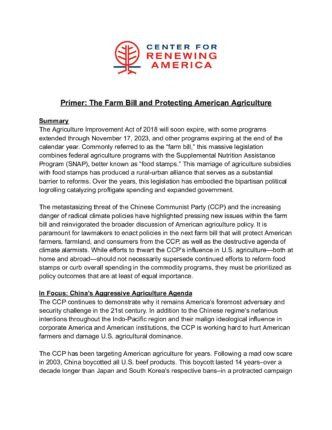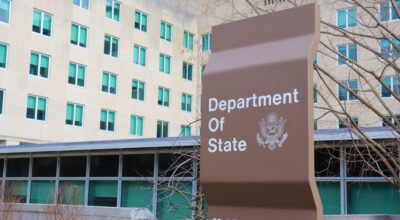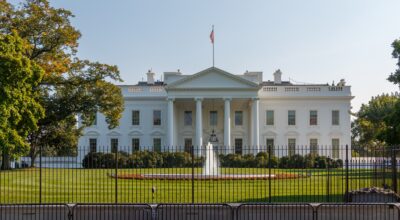
Primer: The Farm Bill and Protecting American Agriculture

Summary
The Agriculture Improvement Act of 2018 will soon expire, with some programs extended through November 17, 2023, and other programs expiring at the end of the calendar year. Commonly referred to as the “farm bill,” this massive legislation combines federal agriculture programs with the Supplemental Nutrition Assistance Program (SNAP), better known as “food stamps.” This marriage of agriculture subsidies with food stamps has produced a rural-urban alliance that serves as a substantial barrier to reforms. Over the years, this legislation has embodied the bipartisan political logrolling catalyzing profligate spending and expanded government.
The metastasizing threat of the Chinese Communist Party (CCP) and the increasing danger of radical climate policies have highlighted pressing new issues within the farm bill and reinvigorated the broader discussion of American agriculture policy. It is paramount for lawmakers to enact policies in the next farm bill that will protect American farmers, farmland, and consumers from the CCP, as well as the destructive agenda of climate alarmists. While efforts to thwart the CCP’s influence in U.S. agriculture—both at home and abroad—should not necessarily supersede continued efforts to reform food stamps or curb overall spending in the commodity programs, they must be prioritized as policy outcomes that are at least of equal importance.
In Focus: China’s Aggressive Agriculture Agenda
The CCP continues to demonstrate why it remains America’s foremost adversary and security challenge in the 21st century. In addition to the Chinese regime’s nefarious intentions throughout the Indo-Pacific region and their malign ideological influence in corporate America and American institutions, the CCP is working hard to hurt American farmers and damage U.S. agricultural dominance.
The CCP has been targeting American agriculture for years. Following a mad cow scare in 2003, China boycotted all U.S. beef products. This boycott lasted 14 years–over a decade longer than Japan and South Korea’s respective bans–in a protracted campaign to isolate and leverage economic pain against a specific subset of American producers.1 Other U.S. agriculture industries have experienced similar aggressive behavior from the CCP over the past few decades.
American farmers have repeatedly pointed out that the CCP has canceled orders of corn or grain without explanation or forewarning. During the Obama administration, the CCP explicitly targeted genetically modified corn-based products from the U.S. with the implementation of a “zero tolerance” policy in a move that left corn exports rejected, delayed, or deferred.2
Since 2011, numerous Chinese nationals have been arrested and convicted for digging up hybrid seeds in Iowa and sending them back to Beijing, stealing millions in U.S. agricultural technology, and committing conspiracy to engage in economic espionage by illegally procuring farming algorithms from companies like Monsanto.3
More recently, it was only thanks to the vigilance of citizens in North Dakota that the Fufeng Group, a Chinese chemical company with direct ties to the CCP, was unsuccessful in its attempt to buy up farmland near Grand Forks Air Base.4 This same company is working to corner the global market on amino acids—critical for animal feed—to ensure the United States is reliant on the CCP for the health of its livestock. This effort threatens the broader U.S. supply chain—in particular, the security of Americans’ supply of food.
During the Trump administration, the CCP escalated its attacks on U.S. agriculture in direct response to U.S. tariffs imposed on Chinese solar products, aluminum, and steel. Among the actions taken by the CCP were a 25 percent tariff on U.S. soybeans and pork products as well as a 50 percent tariff on cotton.5 At the time, the actions taken by the CCP resulted in the Trump administration redirecting significant funds from the tariff accounts to provide financial relief to American farmers.
Throughout all of this, China has operated under most-favored-nation status, even as the U.S. trade deficit with China has increased to $383 billion and continues to rise.6 China continues to manipulate this disparity with aggressive and retaliatory tariffs intended to damage U.S. farmers and agriculture. The World Trade Organization (WTO) recently sided with the United States after it found the CCP’s 25 percent tariff on U.S. pork products and 15 percent tariff on wine and specialty crops violate WTO guidelines.7
Further, the CCP is aggressively buying up farmland in the United States and agricultural processing facilities around the world. While China owned just 1 percent of all foreign-owned farmland in the United States at the end of 2021, this amounts to roughly 384,000 acres valued at more than $2.1 billion.8 Meanwhile, the CCP has purchased more than 1,300 agricultural processing facilities outside of China to gain greater control over global food supply chains.9
It is clear that the CCP has a broader strategy to contain U.S. agriculture, impose greater dominance over domestic and global supply chains, and wield food as a weapon of economic warfare against the United States. While Congress has done a better job of taking the threat of the CCP seriously through the creation of the House Select Committee, lawmakers must use every legislative opportunity to contain the CCP and the farm bill is no exception.
Key Farm Bill Concerns
In some respects, the substantive issues in the farm bill have not changed in several decades. Congress continues to spend far too much taxpayer money on food stamps, continues to fail to enact common-sense work requirements, and continues to bless far too much central planning over various commodity programs.
However, the Left’s insistence on using agriculture policy as yet another vehicle to impose cost-driving climate zealotry on American farmers and consumers poses a new and pressing threat. This radical fealty to climate alarmism, in addition to trade policies that overly favor communist China and allow Beijing and its corporate clients to gobble up American farmland, should prompt new policy priorities for any reauthorization of a farm bill.
As such, here are the top China and climate-related policy concerns in a farm bill reauthorization.
Trade Vulnerabilities
The United States continues to operate with China, its foremost adversary, afforded the most-favored-nation status when it comes to trade. While the 2018 farm bill began a long overdue effort to streamline marketing access programs,10 Title III does not contain sufficient statutory measures to curb America’s growing trade vulnerabilities posed by the CCP’s agriculture export mitigation strategy and targeted tariff campaigns.
China continues to be the top destination for U.S. agriculture exports–totaling a record $40.9 billion in 2022.11 Leading agricultural exports to the CCP include soybeans (52 percent share of all U.S. exports), corn (28 percent share of all U.S. exports), cotton (32 percent share of all U.S. exports), beef (19 percent share of all U.S. exports), and coarse grains (84 percent share of all U.S. exports).12
American farmers currently rely heavily on the CCP for the purchase of their products. Therefore, aggressive defense of U.S. agricultural markets—as well as other key exports—is critical for the success of America’s farmers, domestic and international food supply chains, and the nation’s national security.
Intellectual Property Theft
The increasingly brazen nature of the CCP’s efforts to steal U.S. technology and copy patents in the agricultural sector is an emerging national security issue. Further, such activity could lead to future developments in China’s agricultural sector that threaten the growth of U.S. exports and the dominance of American agriculture as a whole. The farm bill—in its current iteration—provides few countermeasures to thwart the CCP’s aggressive efforts when it comes to intellectual property.
Communist Land and Property Grabs
While only 3 percent of all U.S. farmland is foreign-owned, the acceleration of the CCP’s land acquisition efforts poses a direct threat to the American people from both an espionage and a food security perspective. Further, the CCP’s increasing interest in consolidating food and agricultural processing facilities inside the United States underscores the extent to which Beijing seeks to exert greater control over the entire agricultural production cycle.
There are no statutory protections in the current iteration of the farm bill that address this problem.
Climate Change Radicalism
For the first time, the 2018 farm bill locked in radical green energy policies by setting the Rural Energy for America Program (REAP) program on a mandatory funding stream. While the total annual spending is comparatively small at $50 million, the precedent is one of concern. The foundation laid in the 2008 farm bill to link U.S. agriculture policy with climate alarmism has become a major issue in discussions over a new farm bill reauthorization. Specifically, some Senators are currently working to permanently increase baseline farm bill spending through $20 billion in supplemental climate change funding from the Inflation Reduction Act.13
If lawmakers consider a farm bill reauthorization, these policy concerns must be equally important to traditional debates over SNAP and Title I commodity programs.
An America First Agriculture Agenda
Each of the policy recommendations and ideas outlined below aims to protect American agriculture from Beijing’s aggression and protect American consumers from the radical Left’s woke climate dogma, putting the American people first.
Preventing CCP Ownership of U.S. Farmland: A reauthorized farm bill should prohibit the CCP, its members, or any entity under the CCP’s influence from purchasing public or private real estate in the United States. Specific emphasis should be placed on farmland, land designated for rural development initiatives, conservation areas, and land owned or managed by anyone who has received federal subsidies, payments, or loans.
One of the ways to accomplish this is to bolster the Committee on Foreign Investments in the United States (CFIUS) into a bulwark against Beijing’s aggressive attempts to purchase agriculture processing centers and related infrastructure throughout the domestic agriculture production chain. CFIUS is a critical tool in thwarting the CCP’s infrastructure and intellectual property grabs, but remains mostly underutilized and ill-prepared for assessing national security risks when it comes to foreign investment.
Congress should amend Section 721 of the Defense Production Act as part of a farm bill reauthorization to make both the Department of Defense and the USDA equal co-chairs of CFIUS alongside the Department of Treasury. Further, Congress should ensure that attempted land grabs and infrastructure seizures by companies aligned with or under the influence of the CCP are included within CFIUS’ jurisdiction. This will help elevate China’s property seizures as a pressing national security priority while CFIUS personnel conduct mitigation monitoring activities.
Diversifying Market Access: A reauthorization should adopt language in Title III’s trade section that catalyzes broader commodity export diversification within the new Agricultural Trade Promotion Program. Specifically, the program should be statutorily instructed to identify new markets for specific U.S. agricultural products in the Indo-Pacific region and execute a strategic plan to expand these exports over a 10-year period. This will begin the process of ensuring U.S. farmers are not overly reliant on Chinese markets in the future and send a signal to Beijing that the United States intends to leverage our farmers to counter the CCP’s communist ambitions.
Market Access Enhancement: A reauthorization should consider enhancing the Foreign Market Development Program (FMD) in Title III by linking an expansion of market access efforts (outside of China) with existing or new tariff accounts. This not only serves as a more tenable pay-for that avoids statutory increases in the programmatic spending baseline, but also directly links targeted tariffs against Beijing to identifying new markets and new uses for U.S. agriculture products.
Retaliatory Tariffs: Congress should empower the U.S. Trade Representative, USDA, Department of Commerce, and other relevant agencies with the statutory authority to execute a series of escalatory actions based on CCP attempts to spy, steal, or otherwise procure U.S. agriculture technology and land–as well as CCP attempts to engage in currency manipulation or control or damage the U.S. food supply.
For example, if China attempts to impose another 50 percent tariff on U.S. cotton or another 25 percent tariff on U.S. soybeans, targeted tariffs aimed at various Chinese imports should kick in to immediately overwhelm and deter such aggression.
Tariff Relief Trigger: Another potential policy consideration is a statutory trigger that automatically lowers existing tariffs for nations (including any universal baseline tariffs) if they diminish their trade relationship with Beijing and open up their markets to the United States or other friendly nations. The amount of tariff reduction would depend on the commensurate drop-off in trade with China and the increase in trade with the United States or other allied trading partners. This would provide incentives for prospective new agricultural trading partners to avoid strengthening ties with Beijing.
Trade Status Revocation: Any new farm bill reauthorization should modify Title III to explicitly revoke China’s most-favored-nation status and apply new statutory criteria that require a bicameral legislative supermajority to restore such status.
Eliminate IRA Climate Spending: Any new farm bill reauthorization should zero out the $20 billion in carbon sequestration funding provided by the Inflation Reduction Act. This infusion of climate spending is deceptively disguised as “conservation” funding and threatens to convert the entirety of Title II into a massive and permanent green energy subsidy.
Reverse REAP Funding: At a minimum, Congress should reverse its decision to put the REAP program on a mandatory funding stream and put this program back under its annual discretionary purview.
Competitive Grant Clean Up: Congress should prohibit competitive grant approvals in all titles of the farm bill to any organization, entity, individual, or recipient that practices, promotes, embraces, or advances climate justice and derivative ideologies.
Climate Dogma Prohibition: Congress should statutorily prohibit any subsidies, loans, or payment guarantees in Title I commodity programs and Title II conservation programs to any farm, farm corporation, agriculture conglomerate, or business for carbon reduction, climate change mitigation, climate resiliency, carbon sequestration, or green energy development.
Conclusion
The farm bill continues to be one of the worst examples of legislative sausage-making in Washington, D.C. The fusion of rural-urban programmatic interests has bound both parties into decades of dealmaking that benefit special interests while exacerbating excessive spending and the welfare state. However, a radical climate agenda and communist China’s ambitions to throttle American agriculture require lawmakers to look at the farm bill through a fresh prism.
As lawmakers potentially move forward on a farm bill reauthorization, priority must be given to measures that thwart China’s malign attempts to weaken America’s agricultural dominance and use food as a weapon against the American people, as well as nullify self-defeating green energy initiatives that drive up costs for families and consumers. Congress should prioritize policies that put the security and prosperity of the American people above all other considerations. This is not an exclusive consideration for the farm bill. Indeed, every piece of legislation that comes before America’s elected officials should be viewed as an opportunity to put the American people first.
Endnotes
1. Reuters Staff (June 12, 2017). “U.S. Finalizes Talks to Resume Beef Exports to China After Ban,” Reuters. https://www.reuters.com/article/us-usa-china-beef/u-s-finalizes-talks-to-resume-beef-exports-to-china-after-ban-idUSKBN1932ID
2. Jayasinghe, S. and Lyman, P. (July 2017). “U.S. Corn Exports to China: Significant Impact from New Chinese Ag and Trade Policies,” Agricultural Marketing Resource Center. https://www.agmrc.org/renewable-energy/renewable-energy-climate-change-report/renewable-energy-climate-change-report/july-2017-report/us-corn-exports-to-china-significant-impact-from-new-chinese-ag-and-trade-policies
3. Barton, T. (August 3, 2023). “Iowa Farmers: Stop China from Undermining U.S. Agriculture,” The Gazette. https://www.thegazette.com/government-politics/iowa-farmers-stop-china-from-undermining-u-s-agriculture/
4. Norman, G. (February 7, 2023). “Chinese Company’s North Dakota Corn Mill Project Struck Down by Grand Forks, Prompting Cheers of ‘USA’,” FOX Business. https://www.foxbusiness.com/economy/china-fufeng-north-dakota-corn-mill-project-halted-grand-forks-city-council
5. Hopkinson, J. (December 31, 2018). “Profiles and Effects of Retaliatory Tariffs on U.S. Agricultural Exports,” Congressional Research Service. https://crsreports.congress.gov/product/pdf/R/R45448#:~:text=These%20retaliatory%20tariffs%20may%20adversely,agricultural%20products%20in%20value%20terms.
6. Bureau of Economic Analysis (February 7, 2023). “U.S. International Trade in Goods and Services, December and Annual 2022,” U.S. Department of Commerce. https://www.bea.gov/news/2023/us-international-trade-goods-and-services-december-and-annual-2022
7. Abbott, C. (August 17, 2023). “WTO Backs U.S. in Challenge of Chinese Trade War Tariffs,” Successful Farming. https://www.agriculture.com/wto-backs-u-s-in-challenge-of-chinese-trade-war-tariffs-7644572
8. Farm Service Agency (2022). “Foreign Holdings of U.S. Agricultural Land,” U.S. Department of Agriculture. https://www.fsa.usda.gov/Assets/USDA-FSA-Public/usdafiles/EPAS/PDF/2021_afida_annual_report_through_12_31_2021.pdf
9. The Select Committee on the CCP (February 28, 2023). “The Chinese Communist Party’s Threat to America,” U.S. House of Representatives. https://selectcommitteeontheccp.house.gov/committee-activity/hearings/chinese-communist-partys-threat-america
10. Public Law 115-334 (December 20, 2018). “Agricultural Improvement Act of 2018,” U.S. Government Publishing Office. https://www.congress.gov/115/plaws/publ334/PLAW-115publ334.pdf
11. Branson, A. (February 17, 2023). “Highlights of 2022 Record Agricultural Trade with the PRC,” Foreign Agricultural Service.
12. Ibid.13. Hill, M. and Downs, G. (September 18, 2023). “Scoop: Dems Mobilize in Climate-Ag Farm Bill Fight,” Politico. https://www.politico.com/newsletters/weekly-agriculture/2023/09/18/scoop-dems-mobilize-in-climate-ag-farm-bill-fight-00116464




